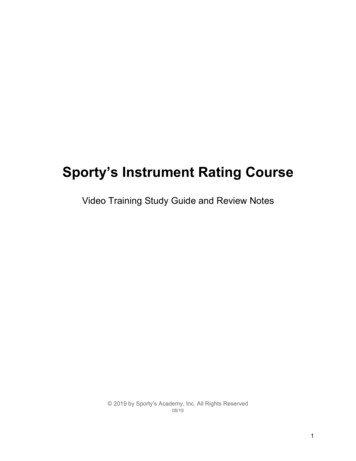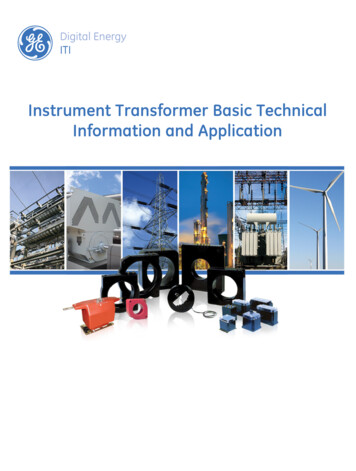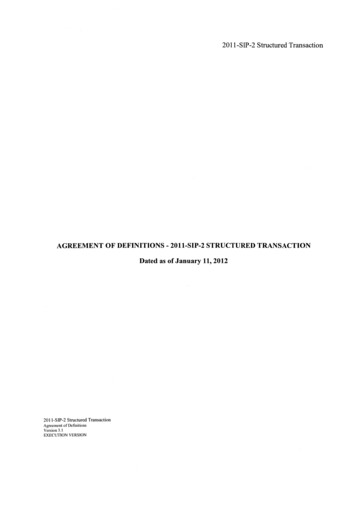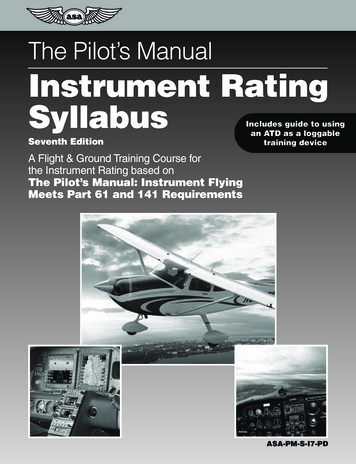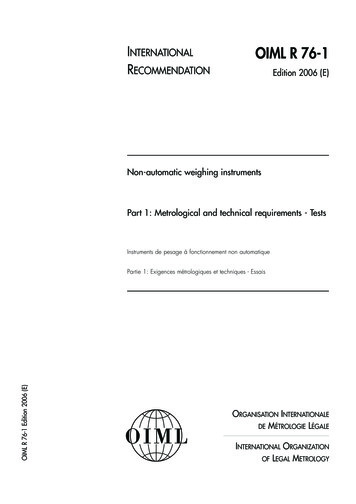
Transcription
FAA-S-8081-4Ew/ changes 1, 2, & 3U.S. Departmentof TransportationFederal AviationAdministrationINSTRUMENT RATINGPractical Test StandardsforAIRPLANE, HELICOPTER,andPOWERED LIFTJanuary 2010FLIGHT STANDARDS SERVICEWashington, DC 20591
INSTRUMENT RATINGPractical Test StandardsforAirplane, Helicopter,andPowered Lift2010FLIGHT STANDARDS SERVICEWASHINGTON, DC 20591
NOTEMaterial in FAA-S-8081-4E will be effective January 2010. All previouseditions of the Instrument Rating—Airplane, Helicopter, Powered LiftPractical Test Standards will be obsolete as of this date.MAJOR ENHANCEMENTSIntroduction1.Added abbreviations2.Deleted Practical Test Prerequisites: Instrument Rating3.Added guidance to conform to current guidance in FAA Orders8900.1 and 8900.24.Added special emphasis area of icing hazards, anti-icing anddeicing equipment and operations5.Replaced APV note with LPV verbiage in Aircraft andEquipment Required for the Practical Test section6.Replaced Aeronautical Decision Making, Risk Management,and Single Pilot Resources Management with new Single-PilotResource ManagementAreas of Operations1.Area of Operation I: Preflight Preparation, added new Task A:Pilot Qualifications, which:a.Moved Task A: Weather Information to Task Bb.Moved Task B: Cross-Country Flight Planning to Task C2.Modified task items to standardize phraseology as contained inthe Aeronautical Information Manual when reading backclearances and communicating with ATC3.Area of Operation I: Preflight Preparation, Task B: CrossCountry Flight Planning, added points 8, 9, and 104.Area of Operation VI: Instrument Approach Procedures, Task A:Nonprecision Approach (NPA)a.NOTE: added sentence that NPA will have no verticalguidanceb.Modified Objective 11 to emphasize stabilized approachprofileAppendices1.Appendix 1 introduction updated2.Added Appendix 2, Judgment Assessment Matrix
RECORD OF CHANGEChange 1 -- 2/5/2010Added the following to pg 9 of the Introduction under Use of FAAApproved Flight Simulation Training Device (FSTD):In order to do so, such devices must be used pursuant to and inaccordance with a curriculum approved for use at a 14 CFR part141 pilot school or 14 CFR part 142 training center. Practical testsor portions thereof, when accomplished in an FSTD, may only beconducted by FAA aviation safety inspectors, designees authorizedto conduct such tests in FSTDs for part 141 pilot school graduates,or appropriately authorized part 142 Training Center Evaluators(TCE).Change 2 – 3/16/2010 Introduction—clarification of Aircraft and Equipment Requiredfor the Practical Test VI. AREA OF OPERATION: Instrument Approach Procedures,TASK A. NONPRECISION APPROACH (NPA), NOTE—clarification.Change 3 – 5/3/2012 Deleted Appendix 2: Non-FSTD Device Credit
FOREWORDThe Instrument Rating Practical Test Standards (PTS) book ispublished by the Federal Aviation Administration (FAA) to establishthe standards for instrument rating certification practical tests for theairplane, helicopter, and powered lift, category and classes. Thesepractical test standards shall also be used for the instrument portionof the Commercial Pilot—Airship practical test. FAA inspectors anddesignated pilot examiners shall conduct practical tests in compliancewith these standards. Flight instructors and applicants should findthese standards helpful during training and when preparing forpractical tests./s/ January 2010Debra J. Entricken, Acting ManagerRegulatory Support Division, AFS-600Flight Standards Service
CONTENTSINTRODUCTION.1General Information.1Practical Test Standard Concept.2Practical Test Book Description .2Abbreviations.4Use of the Practical Test Standards .5Use of the Judgment Assessment Matrix .6Special Emphasis Areas .7Aircraft and Equipment Required for the Practical Test .7Use of FAA-Approved Flight Simulator or Flight TrainingDevice .9Flight Instructor Responsibility .10Examiner Responsibility .10Satisfactory Performance .11Unsatisfactory Performance .11Letter of Discontinuance.12Single-Pilot Resource Management .131. Aeronautical Decision Making .132. Risk Management.143. Task Management .144. Situational Awareness .155. Controlled Flight Into Terrain Awareness .156. Automation Management.16Crew Resource Management.16Applicant’s Use of Checklists .16Use of Distractions During Practical Tests .16Positive Exchange of Flight Controls.17Emphasis on Attitude Instrument Flying and EmergencyInstrument Procedures .17AREAS OF OPERATION CONTENTS.1-iCHECKLISTS AND RATING TASK TABLEApplicant’s Practical Test Checklist. 1-iiiExaminer’s Practical Test Checklist .1-vRating Task Table . 1-viiAREAS OF OPERATIONI.II.III.IV.V.VI.Preflight Preparation.1-1Preflight Procedures .1-3Air Traffic Control Clearances and Procedures .1-5Flight by Reference to Instruments.1-7Navigation Systems.1-8Instrument Approach Procedures.1-9iFAA-S-8081-4E
VII. Emergency Operations . 1-15VIII. Postflight Procedures. 1-18APPENDIX 1: FLIGHT SIMULATION TRAINING DEVICE CREDITTask vs. Flight Simulation Training Device (FSTD) Credit . A1-1Use of Chart . A1-1Flight Simulation Training Device (FSTD) Level. A1-2APPENDIX 2: NON-FSTD DEVICE CREDITTask vs. Training Device Credit (Other Training Devices) . A2-1Use of Chart . A2-1Training Device Level . A2-2APPENDIX 3: JUDGMENT ASSESSMENT MATRIXJudgment Assessment Matrix . A3-1Purpose of the Assessment. A3-2Directions for Completion of the Assessment. A3-2Definitions of Resource Management Areas . A3-2FAA-S-8081-4Eii
INTRODUCTIONGeneral InformationThe Flight Standards Service of the Federal Aviation Administration(FAA) has developed this practical test as the standard that shall beused by FAA examiners1 when conducting instrument rating—airplane,helicopter, and powered lift practical tests, and instrument proficiencychecks for all aircraft. This practical test standard (PTS) shall also beused for the instrument portion of the commercial pilot—airship practicaltest. Instructors are expected to use this PTS when preparingapplicants for practical tests. Applicants should be familiar with this PTSand refer to these standards during their training.This PTS sets forth the practical test requirements for the addition of aninstrument rating to a pilot certificate in airplanes, helicopters, andpowered-lift aircraft.Information considered directive in nature is described in this PTS bookin terms, such as “shall” and “must,” indicating the actions are mandatory.Guidance information is described in terms, such as “should” and“may,” indicating the actions are desirable or permissive, but notmandatory.The FAA gratefully acknowledges the valuable assistance provided bymany industry participants who contributed their time and talent inassisting with the revision of these practical test standards.This PTS may be purchased from the Superintendent of Documents,U.S. Government Printing Office (GPO), Washington, DC 20402-9325,or from http://bookstore.gpo.gov. This PTS is also available fordownload, in pdf format, from the Flight Standards Service web site athttp://www.faa.gov/training testing/testing/airmen/test standards/.This PTS is published by the U.S. Department of Transportation, FederalAviation Administration, Airman Testing Standards Branch, AFS-630,P.O. Box 25082, Oklahoma City, OK 73125. Comments regarding thishandbook should be sent, in e-mail form, to AFS630comments@faa.gov.1The word “examiner” denotes either the FAA inspector, FAA designatedpilot examiner, or other authorized person who conducts the practical test.1FAA-S-8081-4E
Practical Test Standard ConceptTitle 14 of the Code of Federal Regulations (14 CFR) part 61 specifiesthe areas in which knowledge and skill must be demonstrated by theapplicant before the issuance of an instrument rating. The CFRsprovide the flexibility to permit the FAA to publish practical teststandards containing the AREAS OF OPERATION and specific TASKSin which pilot competency shall be demonstrated. The FAA will revisethis PTS whenever it is determined that changes are needed in theinterest of safety. Adherence to the provisions of the regulationsand the practical test standards is mandatory for evaluation ofinstrument pilot applicants.Practical Test Book DescriptionThis test book contains the instrument rating practical test standards forairplane, helicopter, and powered lift. It also contains TASK requirementsfor the addition of airplane, helicopter, or powered lift, if an instrumentrating is possessed by the applicant in at least one other aircraftcategory. Refer to the commercial pilot–airship practical test standard todetermine the instrument TASKS required for that practical test.Required TASKS for instrument proficiency checks (PC) are alsocontained in these practical test standards.AREAS OF OPERATION are phases of the practical test arranged in alogical sequence within each standard. They begin with PreflightPreparation and end with postflight procedures. The examiner mayconduct the practical test in any sequence that results in a completeand efficient test; however, the ground portion of the practical testshall be accomplished before the flight portion.TASKS are titles of knowledge areas, flight procedures, or maneuversappropriate to an AREA OF OPERATION.The applicant who holds an airplane, helicopter, or powered liftinstrument rating will not have to take the entire test when applying foran added rating. The TASKS required for each additional instrumentrating are shown in the Rating Task Table on page 1-vii.Applicants for an instrument proficiency check required by 14 CFRsection 61.57 must perform to the standards of the TASKS listed in theguidance provided on page 1-vii.NOTE is used to emphasize special considerations required in theAREA OF OPERATION or TASK.FAA-S-8081-4E2
REFERENCE(S) identifies the publication(s) that describe(s) the TASK.Descriptions of TASKS are not included in the standards because thisinformation can be found in the current issue of the listed references.Publications other than those listed may be used for references if theircontent conveys substantially the same meaning as the referencedpublications.These practical test standards are based on the following references:14 CFR Part 6114 CFR Part -25FAA-H-8261-1AC 00-6AC 00-45AC 60-22AC 60-28AC 61-134AC 61-84AC 90-48AC 90-94AC 120-51AIMDPsSTARsAFDFDC NOTAMsIAPOthersCertification: Pilots, Flight Instructors, and GroundInstructorsGeneral Operating and Flight RulesAirplane Flying HandbookInstrument Flying HandbookRotorcraft Flying HandbookPilot’s Handbook of Aeronautical KnowledgeInstrument Procedures HandbookAviation Weather for Pilots and Flight OperationsPersonnelAviation Weather ServicesAeronautical Decision MakingEnglish Language Skill Standards Required by14 CFR Parts 61, 63, and 65General Aviation Controlled Flight into TerrainAwarenessRole of Preflight PreparationPilots’ Role in Collision AvoidanceGuidelines for Using Global Positioning SystemEquipment for IFR En Route and TerminalOperations and for Nonprecision InstrumentApproaches in the U.S. National Airspace SystemCrew Resource Management TrainingAeronautical Information ManualInstrument Departure ProceduresStandard Terminal ArrivalsAirport Facility DirectoryNational Flight Data Center Notices to AirmenInstrument Approach ProceduresPertinent Pilot’s Operating HandbooksFAA-approved flight manualsEnroute Low Altitude ChartsThe Objective lists the important elements that must be satisfactorilyperformed to demonstrate competency in a TASK. The Objective includes:1.2.3.Specifically what the applicant should be able to do;The conditions under which the TASK is to be performed; andThe acceptable standards of performance.3FAA-S-8081-4E
Abbreviations14 CFRTitle 14 of the Code of Federal RegulationsAAAdded Rating—AirplaneADFAutomatic Direction FinderADMAeronautical Decision MakingAIRMETSAirman’s Meteorological InformationAMAutomation ManagementAPVApproach With Vertical GuidanceATCAir Traffic ControlATISAutomatic Terminal Information ServiceATSAir Traffic ServiceCDICourse Deviation IndicatorCFITControlled Flight into TerrainCRMCrew Resource ManagementDA/DHDecision Altitude/Decision HeightDHDecision HeightDMEDistance Measuring EquipmentDPDeparture ProceduresFAAFederal Aviation AdministrationFDCFlight Data CenterFITSFAA-Industry Training StandardsFMSFlight Management SystemFSDOFlight Standards District OfficeGLSGNSS Landing SystemGNSSGlobal Navigation Satellite SystemGPOGovernment Printing OfficeGPSGlobal Positioning SystemGPWSGround Proximity Warning SystemHAAdded Rating—HelicopterHATHeight Above TerrainIAInstrument AirplaneIAPInstrument Approach ProceduresIFRInstrument Flight RulesIHInstrument HelicopterILSInstrument Landing SystemIMCInstrument Meteorological ConditionsLAHSOLand and Hold Short OperationsLCDLiquid Crystal DisplayLDALocalizer-Type Directional AidLEDLight Emitting DiodeLOCLocalizerLORANLong Range NavigationLNAVLateral NavigationLPVLocalizer Performance With Vertical GuidanceMAPMissed Approach PointMDAMinimum Descent AttitudeMLSMicrowave Landing SystemNAVAIDNavigation AidNDBNondirectional Beacon (Automatic Direction Finder)NOTAMNotice to AirmenFAA-S-8081-4E4
TSSRMSTARTMTCASVDPVHFVNAVVORNonprecision ApproachNational Weather ServicePrecision ApproachProficiency CheckPowered LiftAdded Rating—Powered LiftPractical Test StandardReceiver Autonomous Integrity MonitoringRisk ManagementRadio Magnetic IndicatorArea NavigationRequired Navigation Performance/AuthorizationRequiredSituational AwarenessStability Augmentation SystemSimplified Directional FacilitySignificant Meteorological AdvisorySingle-Pilot Resource ManagementStandard Terminal ArrivalTask ManagementTraffic Alert and Collision Avoidance SystemVisual Descent PointVery High FrequencyVertical NavigationVery High Frequency Ominidirectional RangeUse of the Practical Test StandardsThe instrument rating practical test standards are designed to evaluatecompetency in both knowledge and skill.The FAA requires that all practical tests be conducted in accordance withthe appropriate practical test standards and the policies set forth in theINTRODUCTION. Instrument rating applicants shall be evaluated in ALLTASKS included in the AREAS OF OPERATION of the appropriatepractical test standard (unless noted otherwise).In preparation for each practical test, the examiner shall develop a written“plan of action” for each practical test. The “plan of action” is a tool, for thesole use of the examiner, to be used in evaluating the applicant. The planof action need not be grammatically correct or in any formal format. Theplan of action must contain all of the required AREAS OF OPERATIONand TASKS and any optional TASKS selected by the examiner. The planof action will include a scenario that allows the evaluation of as manyrequired AREAS OF OPERATION and TASKS as possible withoutdisruption. During the mission the examiner interjects problems andemergencies which the applicant must manage. It should be structuredso that most of the AREAS OF OPERATION and TASKS areaccomplished within the mission. The examiner is afforded the flexibility tochange the plan to accommodate unexpected situations as they arise.Some tasks (e.g., unusual attitudes) are not normally done duringroutine flight operations or may not fit into the scenario.5FAA-S-8081-4E
These maneuvers still must be demonstrated. It is preferable that thesemaneuvers be demonstrated after the scenario is completed. A practicaltest scenario can be suspended to do maneuvers, and then resumed iftime and efficiency of the practical test so dictates. Any TASK selectedfor evaluation during a practical test shall be evaluated in its entirety.The examiner is not required to follow the precise order in which theAREAS OF OPERATION and TASKS appear in this book. The examinermay change the sequence or combine TASKS with similar Objectivesto have an orderly and efficient flow of the practical test. For example,holding procedures may be combined with an approach or missedapproach procedures if a holding entry is part of the procedure.The TASKS apply to airplanes, helicopters, powered lift, and airships. Incertain instances, NOTES describe differences in the performance of aTASK by an “airplane” applicant, “helicopter” applicant, or “powered lift”applicant. When using the practical test standards, the examiner mustevaluate the applicant’s knowledge and skill in sufficient depth todetermine that the standards of performance listed for all TASKS are met.All TASKS in these practical test standards are required for theissuance of an instrument rating in airplanes, helicopters, and poweredlift. However, when a particular element is not appropriate to theaircraft, its equipment, or operational capability, that element may beomitted. Examples of these element exceptions would be high altitudeweather phenomena for helicopters, integrated flight systems for aircraftnot so equipped, or other situations where the aircraft or operation isnot compatible with the requirement of the element.Use of the Judgment Assessment MatrixMost fatal accidents include a lack of SRM skills (task management(TM), risk management (RM), automation management (AM), aeronauticaldecision making (ADM), controlled flight into terrain (CFIT), and situationalawareness (SA)) as a causal factor. Consequently, examiners mustevaluate the applicant to ensure that he or she has the appropriate levelof these skills. A Judgment Assessment Matrix is provided as a tool toevaluate the applicant’s SRM skills objectively. The examiner will usethe Judgment Assessment Matrix during the practical test. Sinceexaminers give multiple tests, it is recommended that examiners makephotocopies of the matrix.FAA-S-8081-4E6
Special Emphasis AreasChange 2 (3/16/2010)Examiners shall place special emphasis upon areas of aircraftoperations considered critical to flight safety. Among these are:1.2.Positive aircraft control;Positive exchange of the flight controls procedure (who is flyingthe aircraft);3. Stall/spin awareness;4. Collision avoidance;5. Wake turbulence avoidance;6. Land and hold short operations (LAHSO);7. Runway incursion avoidance;8. CFIT;9. ADM and RM;10. Checklist usage;11. SRM;12. Icing condition operational hazards, anti-icing and deicingequipment, differences, and approved use and operations; and13. Other areas deemed appropriate to any phase of the practicaltest.With the exception of SRM, any given area may not be addressedspecifically under a TASK, but all areas are essential to flight safety andwill be evaluated during the practical test.Aircraft and Equipment Required for the Practical TestThe instrument rating applicant is required by 14 CFR part 61 to providean airworthy, certificated aircraft for use during the practical test. Itsoperating limitations must not prohibit the TASKS required on thepractical test. Flight instruments are those required for controlling theaircraft without outside references. The required radio equipment is thatwhich is necessary for communications with air traffic control (ATC),and for the performance of two of the following nonprecision approaches:very high frequency omnidirectional range (VOR), nondirectionalbeacon (NDB), global positioning system (GPS) without verticalguidance, localizer (LOC), localizer-type directional aid (LDA), simplifieddirectional facility (SDF), or area navigation (RNAV) and one precisionapproach: instrument landing system (ILS), GNSS landing system (GLS),localizer performance with vertical guidance (LPV) or microwave landingsystem (MLS). GPS equipment must be instrument flight rules (IFR)certified and contain the current database.Note: A localizer performance with vertical guidance (LPV) approachwith a decision altitude (DA) greater than 300 feet height above terrain(HAT) may be used as a nonprecision approach; however, due to theprecision of its glidepath and localizer-like lateral navigationcharacteristics, an LPV can be used to demonstrate precision approachproficiency (AOA VI TASK B) if the DA is equal to or less than 300 feetHAT.7FAA-S-8081-4E
Modern technology has introduced into aviation a new method ofdisplaying flight instruments, such as Electronic Flight InstrumentSystems, Integrated Flight Deck displays, and others. For the purposeof the practical test standards, any flight instrument display that utilizesliquid crystal display (LCD) or picture-tube-like displays will be referredto as “Electronic Flight Instrument Display.” Aircraft equipped with thistechnology may or may not have separate backup flight instrumentsinstalled. The abnormal or emergency procedure for loss of theelectronic flight instrument display appropriate to the aircraft will beevaluated in the Loss of Primary Instruments TASK. The loss of theprimary electronic flight instrument display must be tailored to failuresthat would normally be encountered in the aircraft. If the aircraft iscapable, total failure of the electronic flight instrument display, or asupporting component, with access only to the standby flightinstruments or backup display shall be evaluated.The applicant is required to provide an appropriate view limiting devicethat is acceptable to the examiner. This device shall be used during alltesting that requires testing “solely by reference to instruments.” Thisdevice must prevent the applicant from having visual reference outsidethe aircraft, but not prevent the examiner from having visual referenceoutside the aircraft. A procedure should be established between theapplicant and the examiner as to when and how this device should bedonned and removed and this procedure briefed before the flight.The applicant is expected to utilize an autopilot and/or flightmanagement system (FMS), if properly installed, during the instrumentpractical test to assist in the management of the aircraft. The examineris expected to test the applicant’s knowledge of the systems that areinstalled and operative during the oral and flight portions of the practicaltest. The applicant will be required to demonstrate the use of theautopilot and/or FMS during one of the nonprecision approaches. Theapplicant is expected to demonstrate satisfactory automation managementskills.If an applicant holds both single-engine and multiengine class ratingson a pilot certificate and takes the instrument rating practical test in asingle-engine airplane, the certificate issued must bear the limitation“Multiengine Limited to VFR Only.” If the applicant takes the test in amultiengine airplane, the instrument privileges will be automaticallyconferred for the airplane single-engine rating.An applicant may accomplish an instrument-airplane rating practical testin a multiengine airplane that is limited to center thrust. There is noneed to place the “Limited to Center Thrust” limitation on the applicant’spilot certificate, provided the airplane multiengine land rating is notlimited to center thrust. If the applicant’s airplane multiengine land ratingis limited to center thrust then the limitation will already be on the pilotcertificate.FAA-S-8081-4E8
Change 1 (2/5/2010)If the practical test is conducted in the aircraft, and the aircraft has anoperable and properly installed GPS, the examiner will require and theapplicant must demonstrate GPS approach proficiency. If the applicanthas contracted for training in an approved course that includes GPStraining in the system that is installed in the airplane/simulator/FTD andthe airplane/simulator/FTD used for the checking/testing has the samesystem properly installed and operable, the applicant must demonstrateGPS approach proficiency.NOTE: If any avionics/navigation unit, including GPS, in the aircraftused for the practical test is placarded inoperative, the examiner willreview the maintenance log to verify that the discrepancy has beenproperly documented.Use of FAA-Approved Flight Simulation Training Device (FSTD)An airman applicant for instrument rating certification is authorized touse a full flight simulator (FFS) qualified by the National SimulatorProgram as levels A–D and/or a flight training device (FTD) qualified bythe National Simulator Program as levels 4–7 to complete certain flightTASK requirements listed in this practical test standard.In order to do so, such devices must be used pursuant to and inaccordance with a curriculum approved for use at a 14 CFR part 141pilot school or 14 CFR part 142 training center. Practical tests orportions thereof, when accomplished in an FSTD, may only beconducted by FAA aviation safety inspectors, designees authorized toconduct such tests in FSTDs for part 141 pilot school graduates, orappropriately authorized part 142 Training Center Evaluators (TCE).When flight TASKS are accomplished in an aircraft, certain TASKelements may be accomplished through “simulated” actions in theinterest of safety and practicality, but when accomplished in a flightsimulator or flight training device, these same actions would not be“simulated.” For example, when in an aircraft, a simulated engine firemay be addressed by retarding the throttle to idle, simulating theshutdown of the engine, simulating the discharge of the fire suppressionagent, if applicable, simulating the disconnection of associatedelectrical, hydraulic, and pneumatics systems. However, when the sameemergency condition is addressed in a FSTD, all TASK elements mustbe accomplished as would be expected under actual circumstances.Similarly, safety of flight precautions taken in the aircraft for theaccomplishment of a specific maneuver or procedure (such as limitingaltitude in an approach to stall or setting maximum airspeed for anengine failure expected to result in a rejected takeoff) need not be takenwhen a FSTD is used.9FAA-S-8081-4E
It is important to understand that, whether accomplished in an aircraft orFSTD, all TASKS and elements for each maneuver or procedure shallhave the same performance standards applied equally for determinationof overall satisfactory performance.The applicant must demonstrate all of the instrument approachprocedures required by 14 CFR part 61. At least one instrument approachprocedure must be demonstrated in an airplane, helicopter, or poweredlift as appropriate. One precision and one nonprecision approach notselected for actual flight demonstration may be performed in FSTDsthat meet the requirements of Appendix 1 of this practical test standard.Flight Instructor ResponsibilityAn appropriately rated flight instructor is responsible for training theinstrument rating pilot applicant to acceptable standards in all subjectmatter areas, procedures, and maneuvers included in the TASKS withinthe appropriate instrument rating practical test standard.Because of the impact of their teaching activities in developing safe,proficient pilots, flight instructors should exhibit a high level ofknowledge, skill, and the ability to impart that knowledge and skill tostudents. Additionally, the flight instructor must certify that the applicantis able to perform safely as an instrument pilot and is competent to passthe required practical test.Throughout the applicant’s training, the flight instructor is responsiblefor emphasizing the performance of effective visual scanning, collisionavoidance, and runway incursion avoidance procedures. These areasare covered in part in AC 90-48, Pilot’s Role in Collision Avoidance;FAA-H-8083-3, Airplane Flying Handbook; FAA-H-8083-25, Pilot’sHandbook of Aeronautical Knowledge; and the Aeronautical InformationManual.Examiner ResponsibilityThe examiner conducting the practical test is res
instrument pilot applicants. Practical Test Book Description This test book contains the instrument rating practical test standards for airplane, helicopter, and powered lift. It also contains TASK requirements for the addition of airplane, helicopter, or powered lift, if an instrument rating is possessed by the applicant in at least one other aircraft category. Refer to the commercial pilot .

